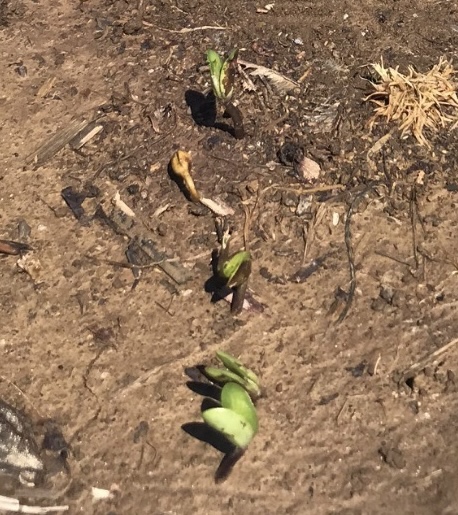With warm soil temperatures in late March, quite a few acres of soybean were planted in Tennessee, including several of our first planting dates across our trials for 2025. Between April 2nd and 6th, 10 – 15+” of rain fell across our state, particularly in West Tennessee. Then, on the mornings of April 8th & 9th, we had some areas with light to moderate frost.
Pictures like the one shown above have been the topic of a few conversations spanning the last 7 days. Soybeans are germinating, with some showing symptoms that appear to be a mix of pythium, frost damage, and even chemical burn.
Pythium, or pythium seedling blight, can cause seed rot and can lead to seedling death as it “dampens off”. Pythium favors wet conditions and cool soils, both of which we have had over the past 2-3 weeks. For seedlings that have emerged, pay close attention to the hypocotyl and cotlyedons, as these areas may have water-soaked lesions present. Pythium outbreaks usually have a focal point, and is not spread widely or uniformly throughout the field like frost-damage.
Frost. Frost damage is always tough to gauge immediately after it happens. The severity of damage as well as the degree to which it will impact seedling survival depend on growth stage and length of exposure. For our specific situation, pay close attention to the growing point, cotlyedons, and hypocotyl. Look for water-soaked lesions. At frost + 5 days (where we are now) you should be seeing healthy stems, cotyledons, and growing points. Assess whether the beans are still in recovery or whether they are dead. The good news is that soybean that had not not emerged at the time of frost will not be impacted, and the above-ground plants are highly resilient. Frost alone usually does not necessitate a re-plant decision.
Delayed Emergence. Early planting often coincides with cooler and wetter soils. This can delay emergence. Additionally, the amount of rain received recently can further delay emergence by not only making the soils wetter, but by compacting the soil surface. Both of these factors increase the time for which germinating seedlings are exposed to any pre-emergent herbicide applied.
Seed Treatments. Seed treatments including fluopyram can at times produce a “halo effect” on the cotyledons. While this may be visually unsettling, it is not a concern.
When one of these is the causal agent of injury to soybean, there is typically little cause for concern. When we start stacking multiple stressors on the plant at time of germination and emergence, a closer look is required.
Parting Shots. Soybean are incredibly and can recover from and compensate for quite a bit. Our recent work has shown 95%+ yield potential from stands as low as 80,000 plants per acre. My re-plant number is still at 60,000 plants per acre. For those contemplating a re-plant decision, waiting until the crop is at VC, or both unifoliate leaves present above the cotyledons, will allow you to make an accurate assessment of plant population. Terminating the existing stand is not necessary, nor is a change in maturity group.
There is more than just a little subjectivity in diagnosing and making these calls. Please reach out at any time with questions.
Jake
931 993 4578


